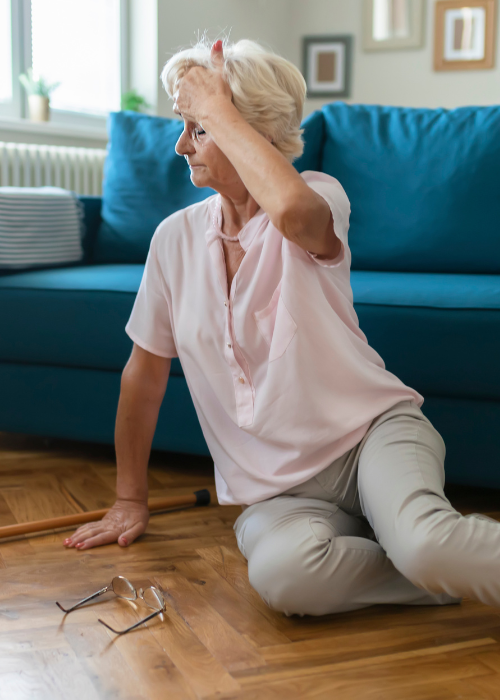September marks National Falls Prevention Awareness Month, a crucial time to highlight the dangers of falls and their significant impact on individuals, especially seniors and those living with brain injuries. At Freedom Mobility, we are committed to providing safe, durable medical equipment and home safety and accessibility solutions that help seniors and those in need stay steady on their feet. According to the Centers for Disease Control and Prevention (CDC), falls account for nearly half of all traumatic brain injury (TBI) hospitalizations. Unlike other common causes of brain injuries, such as vehicle accidents or sports injuries, falls can happen to anyone at any time and in any environment, making them particularly hazardous.
In this blog, we will explore various strategies to reduce the risk of falls, focusing on lifestyle adjustments and home modifications, as well as the potential financial consequences of falls.
Understanding the Risks: Types of Brain Injuries from Falls
Falls can lead to several types of brain injuries, including:
- Mild Traumatic Brain Injury (mTBI): Often referred to as a concussion, this injury occurs when the brain experiences a sudden jolt or impact. Symptoms may include dizziness, headaches, nausea, and blurred vision.
- Contusion: A bruise on the brain resulting from a blow to the head, which can cause bleeding and swelling.

- Hip Fractures: These are frequent after a fall, particularly in older adults. Hip fractures often require surgery and long-term rehabilitation, significantly impacting mobility and independence.
What Could a Fall Cost You?
The financial repercussions of a fall can be significant. Costs associated with fall-related injuries may include:
- Medical Expenses: Hospital visits, surgeries, rehabilitation, and ongoing medical care can quickly add up. For example, the average cost of a hospital stay for a fall-related injury can range from several thousand dollars to over $30,000, depending on the severity of the injury.
- Loss of Income: A fall can result in time away from work, leading to lost wages. This is especially concerning for individuals who are self-employed or lack paid sick leave.
- Long-Term Care Costs: In cases where a fall results in severe injury or disability, ongoing care may be necessary. This can include home modifications, hiring caregivers, or relocating to assisted living facilities, which can be financially burdensome.
- Insurance Premium Increases: Following a fall, individuals may face higher health insurance premiums or increased costs for home and liability insurance as a result of claims related to injuries.

Preventing Falls: Lifestyle Changes
- Stay Active: Regular exercise strengthens muscles and improves balance. Consult with physical and occupational therapy professionals for personalized programs that suit your needs.
- Use Assistive Devices: Consistent use of canes, walkers, and rollators can significantly reduce the risk of falls when used properly.
- Home Safety: Keep pathways clear, ensure proper lighting, and use non-slip rugs. Install stairlifts, grab bars, and ramps where appropriate, and consider other safety modifications in bathroom areas.
4. Routine Health Checks: Schedule regular eye exams and medication reviews to identify any factors that may increase your fall risk.
5. Consider an Aging Life Care Manager: A comprehensive approach to reducing falls may involve hiring an aging life care manager who can coordinate services tailored to your needs.
6. Seek Assistance: If you require help with activities of daily living, supervision for safety reminders, or physical assistance, consider hiring help in the home.
Making Your Home Safer
- Address Uneven Surfaces: Check for uneven flooring in your home and consider replacing or repairing these areas. You might also consider using threshold mats to help even out surfaces, making transitions between rooms smoother. Keep pathways free of clutter and hazards.
- Install Support Bars: Adding grab bars or railings in high-risk areas, like staircases and bathrooms, can provide additional support and stability.
- Improve Lighting: Ensure all areas of your home are well-lit, with easy access to light switches to prevent falls in dark areas.
- Avoid Ladders and Stepstools: If you’re at high risk for falls, it may be wise to avoid using ladders and stepstools altogether. Seek help from friends or hire professionals for tasks that require climbing.
- Consider a Stairlift: If navigating stairs is a challenge, a stairlift can provide a safe and efficient way to move between floors without the risk of falling. This solution is especially beneficial for individuals with mobility issues, offering peace of mind and independence.
By incorporating these lifestyle changes and home safety measures, you can significantly reduce your risk of falls and the associated risk of sustaining a brain injury. Awareness is crucial, not just in September during National Falls Prevention Awareness Month, but throughout the year. The financial impact of a fall can be severe, making prevention all the more essential.
At Freedom Mobility Solutions, we have an expert team with extensive product knowledge, including CAPS and CEAS certifications, physical therapists, and ATPs, ready to help you find tailored solutions for your unique situation. If you have questions about mobility aids or modifications for your home, don’t hesitate to reach out to us. Your safety and well-being are our top priorities!